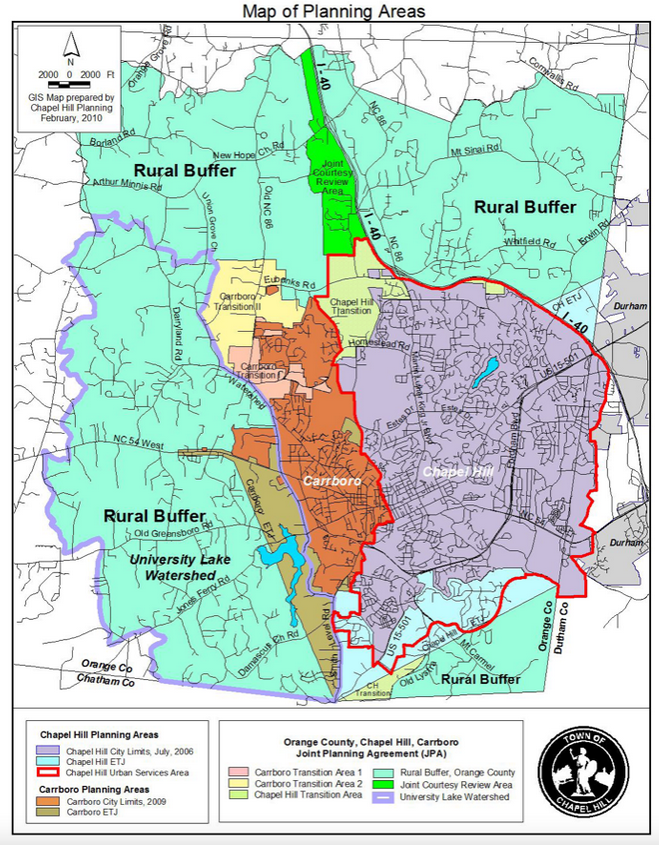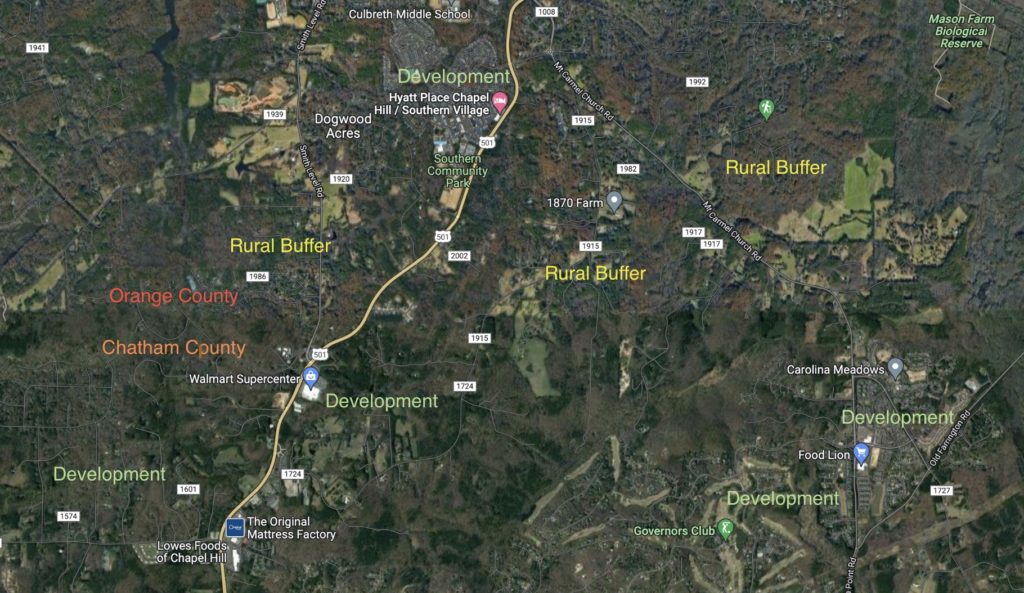This is part of our Harder Truth series.
The Rural Buffer, enacted in 1987, was not utilized correctly, and needs to be reconsidered. (If the town is not going to build densely, which was part of the Buffer deal, then we should scrap the buffer. The Buffer has ‘preserved open space’ in a hyperlocal way of little environmental significance to the region.)
In 1987, Orange County, Carrboro, and Chapel Hill jointly agreed to create a “rural buffer” around Chapel Hill and Carrboro. The buffer – some 35,000 acres of land – was designed to “avoid the suburban sprawl that was happening in so many other places.”

The idea behind the buffer was this: the buffer would remain rural in character, and growth would take place both in town or in “Transition Areas,” which bordered the rural areas.
But the Buffer has not been utilized correctly, and we need to reconsider it. Here’s why:
Chapel Hill and Carrboro haven’t kept up their part of the bargain
The Rural Buffer is nice – you can drive out of Chapel Hill and be amongst the rolling hills of farmland and cows within minutes. But it has always been part of a bargain: We can keep the pastures if we grow inside of Chapel Hill and Carrboro’s boundaries.
But we haven’t.
As Patrick McDonough recently pointed out in his excellent piece, “The Fundamentals of Carrboro,” “all the other communities surrounding Chapel Hill and Carrboro have grown by at least 20%, while Chapel Hill and Carrboro have grown at less than half the rate of the others.” This impacts communities outside of Orange County, like Durham, Pittsboro, and Morrisville, but also communities in our county, such as Hillsborough and Mebane.
Sprawl has happened anyway.
If you look at the county’s land use map of southern Orange County, you see the rural buffer in action. A relatively dense road network in Chapel Hill and Carrboro gives way to open space.
But if you look across the Chatham County line, you’ll see all kinds of development. Governor’s Village has hundreds of homes, and, like other large developments (Briar Chapel, Fearrington Village) attract residents who shop and work in Chapel Hill. While these communities are internally compact, with sidewalks and greenways, they are not well connected to our transit systems, making these neighborhoods dependent on cars for almost all trips.
And, of course, if you keep driving down 15-501 you’ll see a fast developing line of sprawl, with megaprojects like Chatham Park bringing tens of thousands of car dependent households to our region. While we welcome new residents, we think it would be better if they were able to live in Orange County, particularly along the 15-501 corridor.

What is the purpose of the rural buffer?
The Buffer is a tricky political issue — everyone likes rolling hills and picturesque farmland! — but it comes at substantial costs. So what should we do?
One answer might be for us to decide what we want the rural buffer to accomplish.
If our goal is to reduce urban sprawl, the rural buffer has failed. The exact kind of growth we wanted to avoid has happened, but in Chatham County, Durham County, and northern Orange County, meaning that people are driving through the rural buffer to get to work and shopping.
If, on the other hand, the goal of the rural buffer is to preserve open space, we have many success stories in our community. Already, the Triangle Land Conservancy alone has preserved 20,000 acres in our region, including several sites in Orange County. Some of these sites were in the rural buffer, while others were not. Regardless, they are both protected from development and made available to all.
Let’s preserve land for all, not just restrict development.
We should expand the amount of protected, public open space by deploying federal, state, and local resources to protect and preserve farmland, forests, and watersheds, which is already a statewide priority.
By focusing on making land publicly accessible, we can make sure that our policies are not subsidizing multi-million dollar estates at the expense of those who would like to live and work close to Chapel Hill and Carrboro.
Most likely, this would mean that some of the rural buffer would be developed. But it would also mean that we would be able to protect thousands of acres of Orange County and make this land accessible to everyone.
Where should we start?
While our historic districts limit development near downtown, the rural buffer stops us from building housing on major road corridors. Although our first preference would be for more housing in Chapel Hill and Carrboro, the past thirty years has shown that our communities are not capable of permitting enough housing to meet demand.
At the same time, we don’t want new housing to encourage sprawl, but to fill in needed housing along already busy roads, such as 15-501 and 86. We imagine any such proposal to change the rural buffer would ask for the following:
- In addition to the rural buffer, we should consider developing land that is controlled by Chapel Hill and Carrboro, but outside of town limits. (For more on extra-territorial jurisdiction, see this resource.)
- If and when we explore building on land currently in the rural buffer we should start with property that is already developed, containing houses and other buildings. Any new development should increase the amount of housing on the land, and minimize disruption.
- For every acre of land that is developed, the towns and county should ensure that an equivalent amount of land is permanently protected, preserved, and made accessible.
- Transportation alternatives, such as bus access and greenways, should be built into the development of land that’s currently in the rural buffer. Our major transportation corridors already have some limited bus service, and that service will grow over time. For example, while the NS BRT currently stops at Southern Village, it’s very easy to imagine expanded service on 15-501 all the way to Pittsboro. While the Chatham Express route is currently not operating, we could imagine regular service on that line, and making sure that all new housing along 15-501 has easy access to a bus stop.
We support the idea of the rural buffer, but we live in a region, and need to plan accordingly.
Orange County’s decision to create a rural buffer was visionary when it was adopted in the 1980s. But, three decades later we’re seeing the consequences of living in a place with more jobs than homes. We don’t protect the environment by creating a climate in which people have to drive up to an hour to get to work. Saving a few farms near town isn’t worth the cost of developing hundreds of acres of farmland thirty miles away.
This is an obvious point, but climate change doesn’t care about artificial borders. If Orange County wants to really lead the way on protecting the environment, we need to ensure we can build adequate housing. If Chapel Hill and Carrboro refuse to do their share, it’s time to rethink the rural buffer.